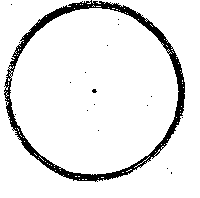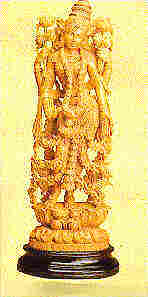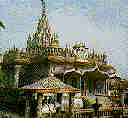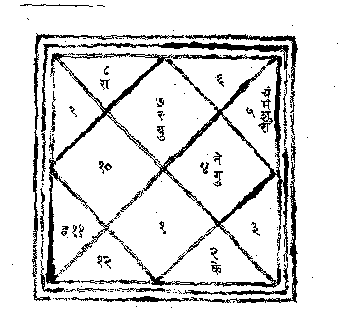CONTENTS
 A
Hindu temple in Bali (Indonesia). Hindu influences were spread over a large
part of the far east through Hinduism and Buddhism. In the Hindu religion
goals like salvation, transmigration, rebirth, are looked upon with reverence.
Hinduism prescribes that, pursuit of goals whose realisation is beyond
our existence in the palpable world around us should be made an organic
part of our activities while we are still living. Further, that each and
every thing that we do here (Karma) is accounted for by the celestial accountant
(chitragupta ) and has implications on our next life as per the theory
of re-birth (Punarjanma) . A
Hindu temple in Bali (Indonesia). Hindu influences were spread over a large
part of the far east through Hinduism and Buddhism. In the Hindu religion
goals like salvation, transmigration, rebirth, are looked upon with reverence.
Hinduism prescribes that, pursuit of goals whose realisation is beyond
our existence in the palpable world around us should be made an organic
part of our activities while we are still living. Further, that each and
every thing that we do here (Karma) is accounted for by the celestial accountant
(chitragupta ) and has implications on our next life as per the theory
of re-birth (Punarjanma) .
In the Hindu religion these goals are elevated to a still higher pedestal. Hinduism prescribes that, pursuit of goals whose realisation is beyond our existence in the palpable world around us should be made an organic part of our activities while we are still living. Further, that each and every thing that we do here (Karma) is accounted for by the celestial accountant (chitragupta ) and has implications on our next life as per the theory of re-birth (Punarjanma) . Traditionally, a devout Hindu elevates himself in the eyes of his co-religionists if he pursues activities of charity (Dana), penance, renunciation, etc., with an eye on a goal whose realisation is possible when the person concerned is no more . This is the goal of release from the cycle of re-birth and is termed Moksha - popularly called Mukti. One may wonder as to how this idea which aims to at regulating the activities of mortal human beings with a promise of reward after death could have come into being. While many conflicting philosophical doctrines exist for explaining and Justifying the concept of Moksha, a student of this subject would sense the answer in the intimate link between the idea of Moksha and that of Karma. It can be seen that the origin of these ecclesiastical doctrines is embedded in real life. The idea of attaining Moksha i.e. release from the cycle of re-birth has in varying degrees been based on the premise that if a person faithfully carries out the duties decreed to him by birth (in a particular Caste) he is rewarded by a more nobler life by being torn in a higher caste and vice-versa. After reaching the highest caste if he continues to perform the duties decreed upon him he can obtain Moksha and his soul (Atman) does not have to be re-born. In theory this doctrine was made applicable not only to human being but to all living creatures. Thus even a dog could be re-born in a higher form of life, e.g. he could be born as a man as member of a particular caste and thus through noble behaviour continue his upward journey till he finally obtained Moksha. But it is clear that this mode of thinking was meant to influence humans and was a tool to impose self discipline among members of various castes to stick to their vocation and station in life as decided by birth. The carrot of re-birth in a higher caste and finally release from the cycle of re-birth, ensured observance of the caste order and discipline in society with minimum need for physical coercion. This was an important reason why slavery which is always based on physical subjugation and coercion) as seen in other civilizations did not need to make its appearance in India. But if at all the carrot of Moksha did not serve its implicit purpose of ensuring caste discipline the Dandaniti (Penal Code) as prescribed by the Dharmashastras (legal literature) was always there to do it. But the need for this was almost non-existent . We do not hear of any caste revolts in ancient India, comparable to the slave revolts in ancient Greco-Roman world - as that of Spartacus for example. The doctrines of Karma and Moksha represented
a neat integration of religion into the social structure. This integration
was never so perfect in other civilizations. Its existence in India, helped
to strengthen the immobility between different castes, because according
to these doctrines a person could move into a higher caste only in his
next life and that also was possible provided he faithfully carried out
the duties assigned to the caste in which he had been born in his 'present'
life. Hence the doctrines precluded any outside chance of a person trying
to infiltrate into another caste by dint of hard work, enterprise or coercion.
The Bhagvad Geeta (Song of the Blessed Lord) says "Karmanya Vaadhi Kaarasthe, Ma Faleshu Kadachana." "A mortal should go about performing his duty without any expectation of its fruits." The Social Interpretation of the Message of the Bhagvad Geeta (Song of the Blessed Lord) Thus it helped in cementing the social differentiation that the heredity aspect of the Caste system had introduced. Dis-qualifications and inferior status of any Caste became acceptable when looked upon as a result of deeds (karma) of the individual concerned in his past life or as his fate (Daiva) that had been destined for him by divine will. By providing explanation for every unequal status, these doctrines sapped away the reason for being dissatisfied with status inherited from birth. But these doctrines had many contradictions which were not always evident. The principal religious injunction that is quoted is the one attributed to Sri Krishna who we are told said in the Bhagvad-Geeta that a mortal should go about performing his duty without any expectation of its fruits. Most Indians see in this proclamation an arguement for renunciation. But renunciation only means 'to give up' something, it does not imply that one should dutifully go about the function assigned but not expect the fruits in return. While the proclamation in the Bhagvad-Geeta amounts to saying ' give (and obey) but do not expect anything in return', Renunciation simply means to give up whatever one has. This differentiation could be likened to hair splitting, but it is essential to realise that there is a difference between renunciation as is practised by sages and hermits and the injunction in the Bhagvad-Geeta which is applicable to all human beings in the normal course of living. Thus, this message of the Bhagvad-Geeta which is meant to have a social appeal must have been relevant in the context of the then existing social structure. The Bhagvad-Geeta is not meant for Arjun alone whose vacillation in fighting this relatives in the Mahabharata war is supposed to have been the reason why Sri Krishna recited the Geeta.
The temples of Kedarnath and Badrinath high up in the Himalayas The Bhagvad Geeta also says "There are two pathways to approach peace. One is knowledge by meditation, and the other is work for men of action.". But all this apart, it is inconceivable that a deeply philosophical document such as the Bhagvad-Geeta could have been recited on a battlefield, and that too just before the beginning of a battle. Even a person who has memorised the Geeta takes about two hours to recite it. If one applies human standards, then it would be unrealistic to presume that this text was recited on a battlefield. The Bhagvad-Geeta must have been composed in a quite corner by different persons possibly at different periods. It reflects doctrines that are necessary to sustain social structures that have existed in India in historic times. By representing it to have been recited by Lord Krishna the messages of the Geeta could be ensured of divine inviolability. The same can be said of all other religious texts like the Bible and the Koran if their message is interpreted in the context of the socio-economic set-up of the societies in which these texts were composed. The possibility of the Bhagvad Geeta being conceived by Ved Vyasa (or by different persons) is substantiated by the obvious cross-purposes between its various injunctions. For instance, the above injunction of carrying out duties without expecting the fruits of labour cannot be reconciled with Sri Krishna's telling Arjun that he need not face any dilemma while battling his relatives because if he wins the battle he would obtain the kingdom of earth but even if he loses and is killed he would still gain the kingdom of heaven Thus Arjun has to be motivated to fight by making him aware of the fruits of his deeds. This is one instance of a contradiction within a philosophy which in one way or the other commends performance of duties decreed upon us (by birth - in the context of the social structure that existed in ancient India). This is the interpretation when the message of the Bhagvad Geeta is applied at the societal level and is viewed in one particular social context. There is another and more universal interpretation of the Geeta when one applies its message at the individual and personal level. Let us see what the Bhagvad Geeta has to say:
A Hindu Temple. The Bhagvad Geeta also says "Once attachment for the objects of the senses is given a place in the mind it will be disastrous. Because attachment gives rise to desire and desire breeds anger. The next step is delusion and the mind gets confused and understanding is lost. Destruction follows in its wake. So, the senses should be controlled, and the man into whom all desires enter as the waters enter the sea, attains peace.". The Universal Appeal of the Message of the Bhagvad Geeta The Bhagvad Geeta says "Work of any kind should not be given up. Work has to be performed. But it should be done with surrender of all attachment for the fruits. This does not mean that one should renounce duty. It should be performed and only the fruits and attachment should be renounced. The doer who is free from attachment, who had no feeling of 'I', who is steady and zealous, who is unmoved by success or failure, whose mind is unattached everywhere, who has subdued his self and has no desires is worthy of becoming one with God." The Bhagvad Geeta also says "Once attachment for the objects of the senses is given a place in the mind it will be disastrous. Because attachment gives rise to desire and desire breeds anger. The next step is delusion and the mind gets confused and understanding is lost. Destruction follows in its wake. So, the senses should be controlled, and the man into whom all desires enter as the waters enter the sea, attains peace." "There are two pathways to approach that state. One is knowledge by meditation, and the other is work for men of action. Remember, no man can be still, even for a moment. He has to do work. It is the law of nature that man should work. You may find a man who sits without doing anything. But his mind is still engaged in the world of the senses. He is a hypocrite. There is then the other type of man, the Stithaprajna I spoke about. he has controlled his senses along with the mind, and when he works he does so without attachment. He is infinitely superior to any other kind of man. You must do your duty. By not working you cannot live. Even the bodily functions need work to sustain them. How then, can one escape the bondage of
work? By performing work as a sacrifice. Give up your attachments and work
as though you are performing a sacrifice for the general good. That is
the secret of work well done. Work should be done so that others benefit
from it and not you."
Bindhu or point. The Hindu philosophical concept of Shunya or void was instrumental in the derivation of both; the concept of 'zero' and the concept of merging into the void of eternity by negating 'self'. The social corollary of this doctrine of negating the self was - renunciation, self-sacrifice and piety. Renunciation is selfless work. True renunciation is renunciation of desire and nothing else. (Here we see how close the Bhagvad Geeta is to Gautama Buddha's teachings.) Work is the only means to attain the yoga of renunciation. Once it is attained, serenity comes to the mind of its own accord." (These passages are quoted from the Mahabharata translated by Kamala Subramaniam and foreworded by K.M.Munshi, Published by Bharatiya Vidya Bhavan , Mumbai 1988, Pp 430-435) In an excellent and powerful commentary on the Bhagvad Geeta, Swami Vivekananda has said, "He works best who works without any motive, neither for money, nor for fame, nor for anything else; and when a man can do that, he will become a Buddha, and out of him will come the power to work in such a manner as will transform the world. This man represents the very highest ideal of karma-Yoga." (Quoted from Karma Yoga by Swami Vivekananda Published by Advaita Ashrama, Calcutta 1994, P 131) Thus we can see that these ideas have a profound implication when applied in the context of an individual's approach to life and another implication when interpreted in the context of the social structure of the society and times in which they were composed. Needless to add here that be it the Bible or the Koran or any other religious text the implications at a social level and at the personal level would be more or less similar. In present-day India, the social structure in the context of which the Bhagvad Geeta had a social relevance is disappearing, but the universal appeal of the Bhagvad Geeta remains relevant and will always remain relevant for all time to come, as will that of all other religious texts. Consequently, ideas about Karma, Daiva and Moksha are losing their social relevance But they continue to be a part of an average Indian's temperament. this is partly because these habits of thinking, have crystallized and refuse to die easily In part, the reason for their survival is that they provide an escape from those harsh realities of our day-to-day life that we cannot overcome. They soothingly reduce the mental burden of helplessness and failure and enable us to reconcile with them. Upavasa The next social practice we take up is that of Upavasa i.e. fasting on certain holy days. Fasting on festivals and other days of religious significance is not new to an Indians We have also observed that on certain occasions like thread ceremony, marriage or death in the family an Indian shaves (tonsures) his head. This is even done while visiting an important shrine normally in fulfillment of a boon e.g. at the Tirupati shrine in Southern India. It may even surprise us to see people walking over hot coals, puncturing cheeks, ears and tongue, etc. That could be the origin of such strange practices which are a part of worship? What is the nature of worship itself ?
Laxmi - the Goddess of Wealth Worship of Goddess of Wealth is an important part of the ritual during Vijayadashmi (Dassera) and Laxmi-Pujan during Diwali. Goddess Laxmi is invariably found at most Hindu business establishments and homes. All of us know that we are taught to pray to the Almighty. The term almighty itself speaks for our concept of divinity. Something that is supreme, all-powerful can be looked upon as God. Fear, need and helplessness evoke awe and respect followed by worship. This is why, natural phenomena like, thunder, lightning, a mighty river especially one causing floods, etc. were objects of worship in ancient times. Ignorance about the nature of a thing alongwith its having a determining influence on human lives have been reasons for such things being elevated to the status of a deity. The word for fasting i.e. Upavasa itself means to move near ( to the Supreme) and by implication to overcome helplessness. A calamity has always been an occasion for prayer. But in normal times we pray for a positive reason like asking for a boon. Appeasement of an anger deity has also been a cause for prayer. But whatever the reason for prayer a common feature is; the offerings that are made. No prayer can be complete unless accompanied by an offering. In earlier times, sacrifices of animals and human beings were offered to propitiate the Gods. In the present day the items we offer have changed but the practice remains, We never go to temples or churches empty-handed, coconuts, flowers, sweets, candle-sticks, etc., are items that we take along as offerings. Thus the concept of give and take during worship has existed since ancient times till today. The origin of customs like fasting must lie near by this nature of worship. Human society has always had, haves and have-nots. During worship the haves had something to offer, but the have-nots did not. The practices of fasting, tonsuring the head, puncturing parts of the body and other forms of self torture could have originated in the section of have-nots as they had nothing else to offer when asking for a boon. Even today, practices like puncturing the tongue, ears, etc. are prevalent mainly among backward tribals living on the margin of subsistence. Another possible reason which universalised some of these practices, fasting for instance; could be that fasting and other forms of penance was undertaken when normal offerings failed in getting a boon fulfilled. Penance itself is of two types. Penance undertaken before the boon is fulfilled and that undertaken after its fulfillment. Penance before a boon is fulfilled is in the nature of a price paid in advance for something to be received in the future. Penance after fulfillment of a boon asked for ia undertaken as a price for something already received. But in both forms the penance has the nature of a price arising out of a mutual obligation between the devotee and his deity. There is no penance in which the devotee does not seek a boon or a favour and there is no boon that can be had without penance or offerings. These two elements are inseparable in worship. Worship and prayer become purposeless if the aspect of a boon or favour is removed from it. While praying we seek something. This something could be a definite object or it may be mental peace and protection from calamities. A prayer, without the asking of a favour does not exist. Hence, normally religions activities cannot be considered to have been undertaken with a selfless motive. A conditional exception can be made about hermits and ascetics (Sanyasis) who roam all over or retire to forests or the snow clad Himalayas in search of peace of mind or universal truth. But the fact remains that they also are seeking something and so strictly speaking their activities cannot be termed as self-renouncing.
Since ancient times temples have received generous donations in cash and kind. Seen here is the Kach Mandir in Calcutta. Bhakti and Bhiksha are the two essential elements of worship. While Bhakti i.e. invocation is the method of prayer, Bhiksha i.e. the asking for a boon is the motive behind prayer. Incidentally the Sanskrit word for God is Ishawra, which could be an amalgam of the teo words 'Isha' and 'Vara'. Isha means to wish for something and vara means a boon or gift. Hence t may not be accidental that the name for God means to 'wish for a boon'. (The Students New Sanskrit Dictionary, Devasthali, G.V., Published by K.B. Dhavale) The self and individual oriented nature of any prayer is perceivable in our act of praying. Prayer is normally a link between an individual and the supreme. What an individual asks during a prayer is his or her private affair which is normally not shared with others. Two or more individuals do not pray collectively unless they are meant for a common objective e.g. soldiers praying for victory in war, business partners praying for prosperity of their firm, etc. A point may be raised about the public prayers during which participants pray for world peace, relief for victims of flood or famines. It can be said that such prayers are for others and not for ourselves, thus the motive is charity. It is true that such prayers have a charitable and selfless character but even here we pray as humans for other humans. We are selfless individually but are not so collectively as the motive for prayer remains that of asking something from the supreme, which we expect it to grant us. The essence to self motive in worship is visibly demonstrated in our idea of looking upon a particular shrine or deity as more alive to the prayers of devotees (Jagrut Deva) as compared to other shrines or deities . This is further demonstrated by our flocking to the shrine of such a Deity to pray for the granting of our innumerable boons. Thus we can see how our practice of Upavasa is deeply embedded in the mundane aspects of real life. However, practices like Upavasa and Vrata have always had a popular and deep appeal. The following anecdote of Sati Savitri and Satyavan brings out this fact. Savitri was the only daughter of King of Ayodhya. From her childhood days Savitri displayed a very devout temperament towards prayer end worship. As she grew up, her devotion towards spiritual pursuits also increased. Even when she came of age her attitude towards life was very different from that of other girls of her age. Seeing her unusual bent of mind her father grew worried about finding the right match for her. He started looking out for a person who would have a similar bent of mind do that he could be an ideal husband for Savatri. The search for a partner in life ended when Savatri's father met Satyavan who was of royal blood and had similar devotion towards spiritual pursuits. The marriage was solemnised in due course and Savitri and Satyavan began their happy conjugal life. Their common interest drew the two very near to each other. But one day calamity struck and Satyavan fell seriously ill. Savitri prayed with all her devotion and observed Vrata to pray for her husband's recovery. She even fasted for days together to lift the curse of illness from Satyavan. But the gods had decreed otherwise and one day after prolonged illness Satyavan passed away. The God of death Yama duly knocked at the door to claim Satyavan's soul. Savitri pleaded with Yama not to take away Satyavan from her but to no avail. Yama was adamant, it was his duty to take away the soul of a person whose death had been decreed in heaven. Thus Yama picked up the dead Satyavan and started his way towards heaven. While he was proceeding towards heaven, vamp felt that he was being followed by someone. On looking behind he saw Savitri coming behind him to heaven. Yama dissuaded her from following him, as Savitri was still living and hence could not enter heaven. But, Savitri refused to budge and said that she was inseparable from her husband even in death. Looking at Savitri' s undying devotion to Satyavan even Yama was moved and he asked her to demand anything from him except her husband on the promise that she would then return to earth. Pleased at this opportunity, Savitri asked for a son to which Yama duly conceded and started his way back to heaven. After sometime he again looked back and saw Savitri following him. He demanded to know that what she wanted now. Savitri told Yama that she only wanted to be with her husband so that Yama' s boon to her could be fulfilled, as without Satyavan, she could not conceive. Thus caught at his own game Yama had to concede defeat and he returned Satyavan to life. Savitri's devotion to her husband thus made even the Gods change what they had destined for Satyavan . In memory of this mythological event, many Hindu women observe fast on Vata-Purnima day which falls in the first half of June. On this day women visit temples with offerings . A special prayer is performed before the Vata tree to propitiate the Gods for getting their worldly boons granted. Muhurta - Sanctified Time People, the world over believe in astrology. Many of us frequently consult soothsayers and fortune-tellers. Beliefs in good and bad omens, auspicious and inauspicious moments are also widespread. But an Indian is more familiar and habituated with such ideas. During performance of any important function whether it is a naming ceremony (namakaran vidhi or barasa), thread ceremony (janeu sanskar or munja) marriage, etc., an essential part is to ask a pandit to work out the auspicious moment or 'muhurat' when the ceremony should be performed. A Question that naturally comes to an inquisitive mind is, how could this practice of deriving muhurtas have come into being ? All of us know that derivation of a muhurta is nothing but the fixing of a particular time for an-event to be performed in the future. We understand that making a judgement about the future has to be based either on forecasting techniques or on astrology. In this case we know it is based on astrology. the birth of ideas of auspicious and inauspicious moments in the future, lies in our belief in the wider idea of astrology. Astrology is a gift of its close sister discipline astronomy. There could be no astrology without astronomy, as astrology predicts the turn of events in the future with the real or imaginary changes in planetary and star positions. We know that the firmament i.e. the observable universe, has a mechanics of its own. The earth and sun being part of the firmament go about their own movement as per the mechanics. The rotation of the earth on its axis causes day and night and its revolution round the sun causes weather changes. This simultaneous occurrence of weather changes and changes in star patterns both of which recurred year after year in the same way stuck into the memory of ancient people.
This co-relation between a change in star patterns and a change in weather which repeated itself year after year, germinated ideas that star patterns decide weather changes. This interpretation gave birth to ideas that appearance of a particular star spelt prosperity while that of another spelt doom. In India the appearance of a comet (Dhumketu) was looked upon as portending doom. Following this it was not a difficult step to believe that changes in an individuals fortune are also decided - by changes in star patterns. Thus the development of astronomy lead to astrology and to beliefs in the auspicious or inauspicious. Henceforth the practice of consulting learned pandits for derivation of auspicious dates or time in the future could evolve naturally. A positive corollary of such beliefs was the development of the calendar. The intimate link of the early calendar systems with star patterns was very evident in that fact that they were either solar or lunar calendars. The calendar, derived as it was from astronomical observations which also fathered astrology, displays certain primordial evidences of this common parentage. In Sanskrit the word for calendar is Punja or Punjika which also means palm or paw. (Quoted from English-Sanskrit Dictionary by Vaman Shivram Apte, Published by Radha Bai Sagoon, Mumbai 1920) The practice of palmistry must have been the result of linking up of individual fortune with that element of the human body by which a person literally builds his future. This element is obviously the hand, more properly the palm. But there is nothing more in palmistry than this. We know that lines on our palm are a result of the skeletal frame within our hand. For this reasons lines similar to those on our palms are also present on our footsoles, armpits and at all other joints. More so, such lines exist on the palms of a Gorilla or a Chimpanzee too, but none of us would claim to foretell the fortune of any simian this way. Now we move on to examine the Hindu Social
Customs Dowry,
Sati and Child Marriage.
"Sudheer, Lavlesh and the Hindu History team would be happy to receive your valued feedback on this site.We invite you to Sign and Read our Guest book. We also invite you to use our Message Board on Hinduism and Hindu History to start a discussion on any relevant topic".For comments on site mail to [email protected]
|
||||||||||||||||||||
|
|
|
|||||||||||||||||||


 A
Hindu devotee offering prayers at the Triveni Sangam. The Triveni Sangam
at Prayaga is the confluence of the three rivers considered holy by the
Hindus viz., - the Ganga, the Yamuna and the unseen Saraswati. Traditionally,
Hindus go on pilgramage to this confluence as a mark of having renounced
material pursuits in life.
A
Hindu devotee offering prayers at the Triveni Sangam. The Triveni Sangam
at Prayaga is the confluence of the three rivers considered holy by the
Hindus viz., - the Ganga, the Yamuna and the unseen Saraswati. Traditionally,
Hindus go on pilgramage to this confluence as a mark of having renounced
material pursuits in life.





 The
practice of astrology, and its corollary palmistry, must have been the
result of linking up of individual fortune with that element of the human
body by which a person literally builds his future. This element is obviously
the hand, more properly the palm. But there is nothing more in palmistry
than this. We know that lines on our palm are a result of the skeletal
frame within our hand. For this reasons lines similar to those on our palms
are also present on our footsoles, armpits and at all other joints. More
so, such lines exist on the palms of a Gorilla or a Chimpanzee too, but
none of us would claim to foretell the fortune of any simian this way..
The
practice of astrology, and its corollary palmistry, must have been the
result of linking up of individual fortune with that element of the human
body by which a person literally builds his future. This element is obviously
the hand, more properly the palm. But there is nothing more in palmistry
than this. We know that lines on our palm are a result of the skeletal
frame within our hand. For this reasons lines similar to those on our palms
are also present on our footsoles, armpits and at all other joints. More
so, such lines exist on the palms of a Gorilla or a Chimpanzee too, but
none of us would claim to foretell the fortune of any simian this way..